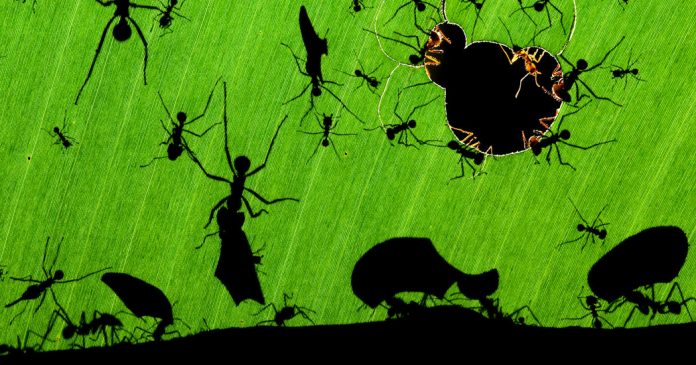Proper now, ants are scurrying round each continent besides Antarctica, doing the onerous work of engineering ecosystems. They unfold seeds, churn up soil and velocity up decomposition. They forage and hunt and get eaten. It’s possible you’ll not understand how a lot you depend on them.
“Ants are the movers and shakers of ecosystems,” stated Nate Sanders, an ecologist on the College of Michigan. “Understanding something about them helps us perceive how ecosystems are put collectively and the way they work.”
“I’d argue most ecosystems would merely collapse with out ants,” stated Patrick Schultheiss, an ecologist on the College of Hong Kong. As some naturalists fear about an insect apocalypse, scientists are racing to maintain monitor of what’s at stake. However they didn’t know what number of ants there are or the place they reside.
Dr. Schultheiss and colleagues have a brand new ant census depend: 20 quadrillion — 20 with 15 zeros following it. Ants outnumber people no less than 2.5 million to 1. Ants biomass is round 20 p.c of human biomass, or the mass of carbon from the almost 8 billion people now residing on Earth. The ant biomass additionally weighs round 12 megatons, which is concerning the equal of two Pyramids of Giza on a scale.
Their estimate, printed on Monday within the Proceedings of the Nationwide Academy of Sciences, assembled censuses of ants residing or foraging on the floor that scientists had beforehand produced world wide. In over 1,300 areas, ants had been collected from leaf litter samples or in pit traps, which they fall into whereas foraging. The researchers used these counts to estimate the abundance of ants for various environments together with tropical forests and arid shrublands.
The examine used a logical, stable strategy, stated Dr. Sanders, who was not concerned within the examine, but it surely hadn’t been accomplished earlier than.
Earlier measures of world ant inhabitants and biomass have been both approximations based mostly on the planet’s complete insect inhabitants or extrapolated from specific components of the world. Estimates for ants’ complete biomass had a variety, from 2.5 megatons of carbon to 70 megatons. The brand new examine as a substitute took a bottom-up strategy, compiling all the current ant counts the authors might discover and dealing up from there.
Dr. Sanders stated the examine’s strategy “is one thing which you can really take a look at and logically get to the identical level the authors bought.”
The true variety of ants is sort of definitely greater than 20 quadrillion as a result of the brand new calculations solely included a conservative estimate for arboreal ants and excluded subterranean ants altogether, Dr. Schultheiss stated. There have been additionally fewer research with the mandatory strategies from some components of the world, resembling central Africa and areas in Southeast Asia, whereas areas like North America and Europe had extra research. As extra analysis is carried out in geographic areas with ant gaps, in addition to in treetops and soils, the ant depend will develop.
“I wouldn’t be shocked if it really seems to be an order of magnitude greater,” stated Sabine Nooten, an ecologist on the College of Hong Kong and a co-author of the examine. “We’re simply scratching the floor.”
Tropical areas are biodiversity sizzling spots for a big swath of crops and animals, and ants aren’t any exception. Almost 70 p.c of surface-foraging ants are in low-latitude biomes, resembling tropical forests and grasslands, the examine discovered. A examine within the journal Science Advances this 12 months discovered the subtropics have a few of the highest ant biodiversity on the planet, and the brand new findings align with that. With tropical forests’ voluminous canopies and recognized densities of arboreal ants, there are more likely to be way more tropical ants within the tropics than present counts.
Getting an up to date ant census was an important step for scientists to trace any adjustments within the bugs’ ecology as they monitor international insect populations for declines. They must know what’s there to know if it’s gone lacking.
“It’s an excellent baseline that I hope will enhance with time,” Dr. Sanders stated. “It’s an actual name to motion for biodiversity scientists world wide not solely to fill in these gaps, but in addition to start out monitoring potential adjustments.”


